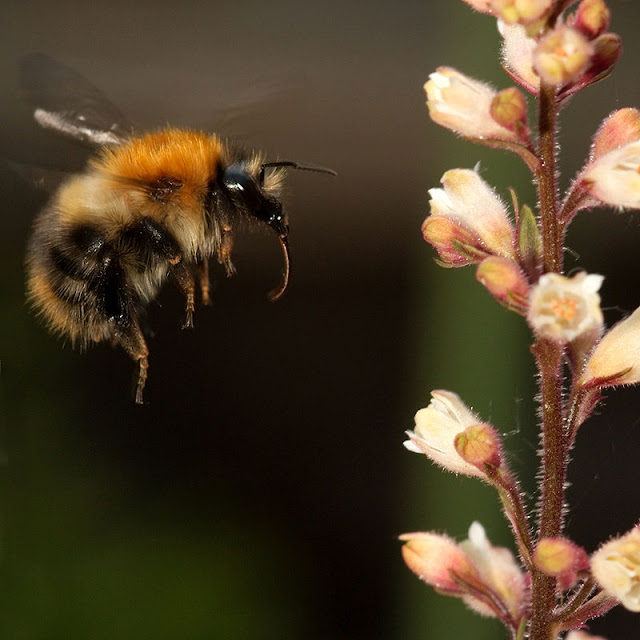Bumblebee Facts Part II
Bumblebee Facts Part II
Image source: "Bumblebee heuchera" by Sffubs - Own work. Licensed under CC BY-SA 3.0 via Commons - https://commons.wikimedia.org/wiki/File:Bumblebee_heuchera.jpg#/media/File:Bumblebee_heuchera.jpg
2. Bumble bees need to beat their wings an astonishing 200 times per second to stay airborne!
It’s A LOT of work being a bee!
3. Different castes (groups or classes) play different roles in a bee nest or colony. Three different castes make up the social structure of a bee colony and include the queen, workers and drones.
4. It’s the job of the worker bees to collect pollen and nectar for the family. To aid them in
pollen collection, they have a special “pollen basket”, called the corbicula, on their hind legs.
It is a small depression surrounded by long hairs which help them carry pollen back to the nest. Upon their return, the worker bees share what they’ve collected.
5. All bumblebees require NECTAR, a sugary solution produced by many flowers, as a high-octane fuel to power their flight. This is sucked up through a tube-like proboscis, commonly referred to as a ‘tongue’.
6. Different species have different ‘tongue’ lengths, specialise in different shapes or types of
flowers, or start their nests at different times in the season.
7. The nectar is a source of carbohydrates and the pollen is an excellent source of protein for
the bee larvae in the nest.
8. Food is stored in wax cells to keep the colony going in bad weather; a colony can last up to
two weeks without foraging before starving to death.
9. THEY HELP THE GARDENER-They are excellent pollinators of currants and other soft fruit, strawberries, runner beans, broad beans, tomatoes, and many other vegetable crops.
10. They are important pollinators of many wild flowers. Scientific research showed that where
bumblebees had declined or become extinct due to intensive agriculture, local populations of wild flowers gradually changed and deteriorated, due to in-breeding and lack of viable seed set.
11. The Garden Bumblebee is a member of the 'Big Six', has the longest tongue, and has a distinct preference for flowers with deeper throats. In centuries past it found traditional gardens, with their borders of herbs and flowers of European wild origin very much to its liking; so much so that Linnaeus named it the ‘Garden Bumblebee’ (Bombus hortorum in Latin).
12. A queen bee lives only one year but may produce as much as 1,000 offspring in that single
year.
13. Only bumblebees are capable of buzz pollination. This occurs when the bee grabs the flower and produces a high pitched buzz. This releases pollen that would otherwise stay trapped inside. Tomatoes are pollinated in this way.


Comments
Post a Comment